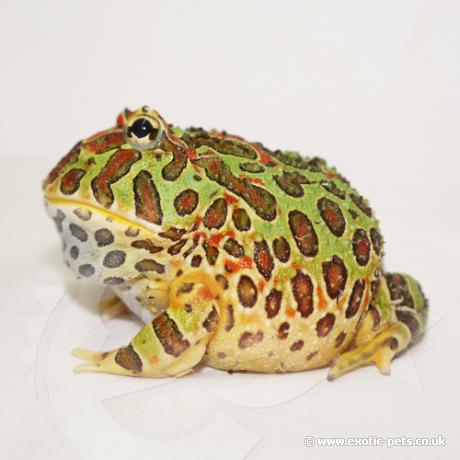

Also, known commonly as Pacman, Argentinian and Chacoan horned frogs. These voracious feeders will attempt to swallow anything that moves close to their mouth.
| Origin | Argentina, Bolivia, Brazil and Paraguay |
|---|---|
| Environment | Arid and Subtropical grasslands |
| Adult Size | Up to 14cm |
| Suitability | Beginner |
| Lifespan | Up to 25 years |
A large bodied frog that has an enormously big mouth compared to its legs and front arms. Its name derives from the fleshy horn that protrudes above its eyes. These frogs possess subtle differences compared to that of (C. ornata) including a longer and more sloping snout.
Naturally these frogs lack bright colours, but they have been selectively bred over generations to produce some truly fantastic looking animals.
Females tend to be the larger of the two sexes, by up to 4cm in length. Males have a blue to grey throat colouration, with loose skin caused by an external vocal sac. Upon maturity, males will also develop horny nuptial pads on their inner toes.
These frogs naturally occur in the Chacoan region of South America, which includes Argentina, Bolivia, Brazil and Paraguay. They camouflage themselves by burying just below the surface within the dry and subtropical grasslands, of which they live.
A hardy frog that will live many years, if maintained in solitary confinement, given a good diet and a clean environment.
These frogs can live in small and fairly basic terrariums, after all, much of their time is spent buried in the substrate. You should consider though, that these frogs grow large, and do become active at night in the search of prey items.
Temperatures should be maintained around 24°C (75°F) during the day, and with a small night-time temperature drop. Unlike (C. ornata) which live in more tropical regions of South America, once these animals reach adult, they prefer somewhat drier conditions.
Providing low level UVB can be beneficial to horned frogs, like with all other exotic animals. This can be achieved by placing an overhead canopy or dome above the terrarium mesh. The only exception would be if you're keeping any albino varieties of horned frog; their eyes can be hypersensitive to bright light. We believe it would still be wise to provide them with UVB light, but compensate by providing more cover such as extra plants so the exposure isn't as great.
When misting, remember that all tap water must be treated with a good quality dechlorinator.
Basic furnishings of sphagnum moss and a leaf litter mixture is sufficient for juveniles; as long as they can bury themselves. Adults can be maintained in larger glass terrariums, where a soil based substrate can be added to further the substrate depth.
Juvenile horned frogs should be fed four to five times a week on a varying and suitably sized diet including; earthworms, locusts, crickets, mealworms and pinkie mice. It should be noted that some of the meal replacement powder diets, work very effectively in rearing young horned frogs.
Adult horned frogs will eat almost anything they can fit in their mouth; including fingers. So, a good pair of feeding tongs will prevent any accidents. With this in mind though, do try and avoid giving them very large food items, as it can cause digestive blockages.
Lastly and most importantly you must use a good quality dusting powder to provide essential calcium and vitamins to your horned frog. The traditional method of application is to use a spare live food tub or empty cereal container to coat the insects lightly in whichever dusting powder you are providing. We’d advise dusting your insects on every feed when your frog is growing but to alternate between calcium and vitamin powders with the ratio of (2.1).